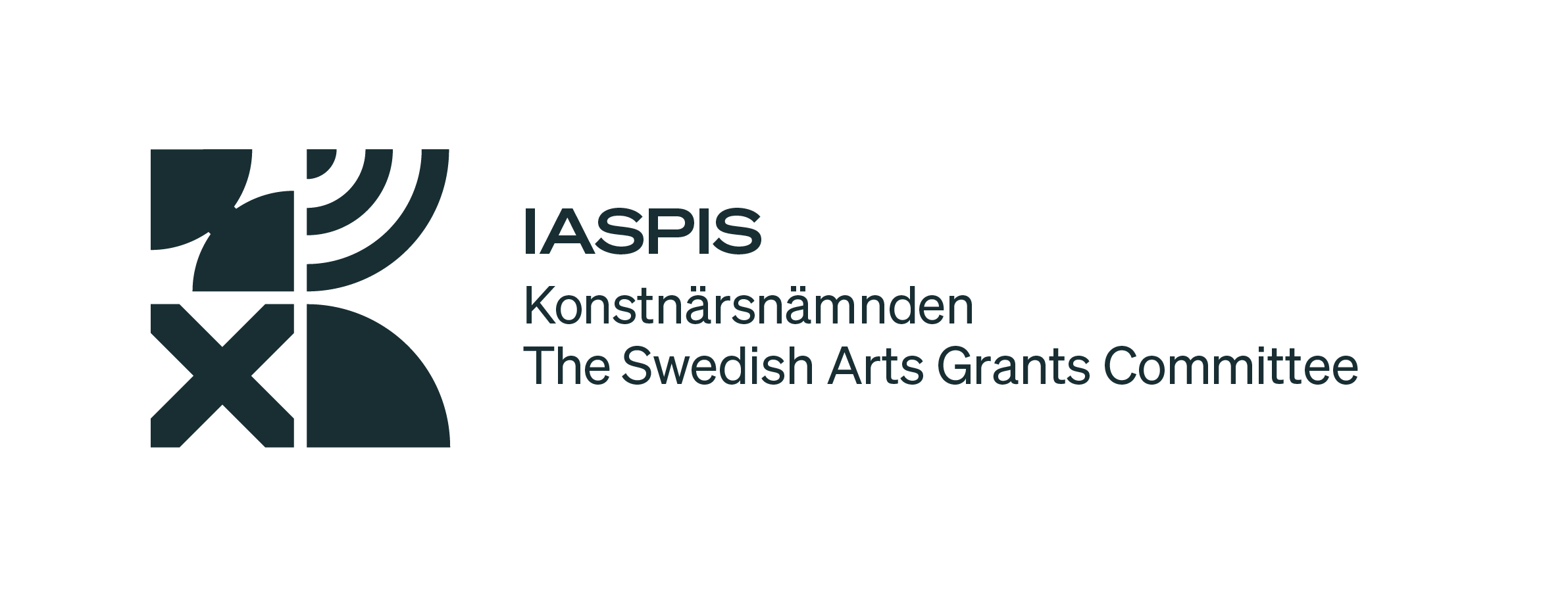Cogenerating spaces of learning
Johanna Gullberg
CATEGORY
Cogenerating Spaces of Learning: The Aesthetic Experience of Materiality and Its Transformative Potential within Architectural Education is a doctoral thesis from 2021. It was made within the educational milieu Making is Thinking at the Norwegian University of Science and Technology (NTNU) in Trondheim.
It is today widely accepted that architects need to change their professional habits if they are to remain relevant actors in an uncertain future marked by ecological and humanitarian crises. At educational institutions, our time is therefore one for reviewing and transforming the pedagogical habits that form the profession.
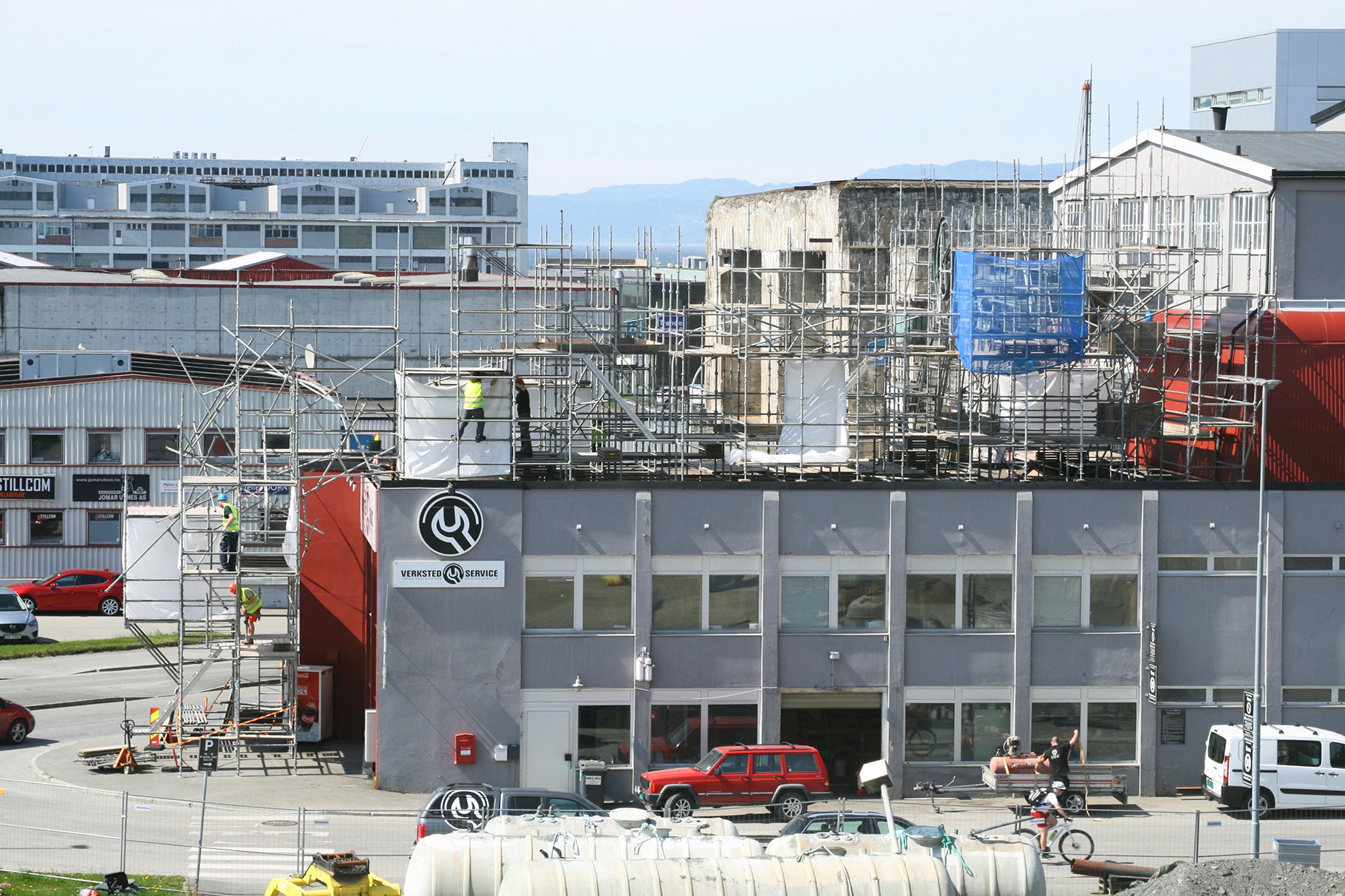
Students testing fabrics in the scaffold they designed and built for exhibitions and performances at the festival Hendelser på Nyhavna on 11th June 2016. Photo by Johanna Gullberg
The Norwegian University of Science and Technology (NTNU) in Trondheim is one of many universities where this challenge is on the agenda, and the doctoral thesis Cogenerating Spaces of Learning: The Aesthetic Experience of Materiality and Its Transformative Potential within Architectural Education, defended at NTNU in 2021 (the thesis may be read in its entirety here), is one response to how states of uncertainty can become possibilities for renewal.[1] What if, the thesis asks, a key to coping with change is to simply let architecture students talk about what they do?
By giving an overview of the history of architectural education, Cogenerating Spaces of Learning shows that there is a general need at architecture schools for working more consciously with pedagogy. There is, to put it bluntly, a need for understanding design processes as learning processes. Based on this perspective, the thesis points to the need for safe spaces for conversations as well as the need for experiments on forms of learning that allow for the experiential. Because by arranging such spaces and experiments, architecture schools may support lasting changes of pedagogical and professional habits.
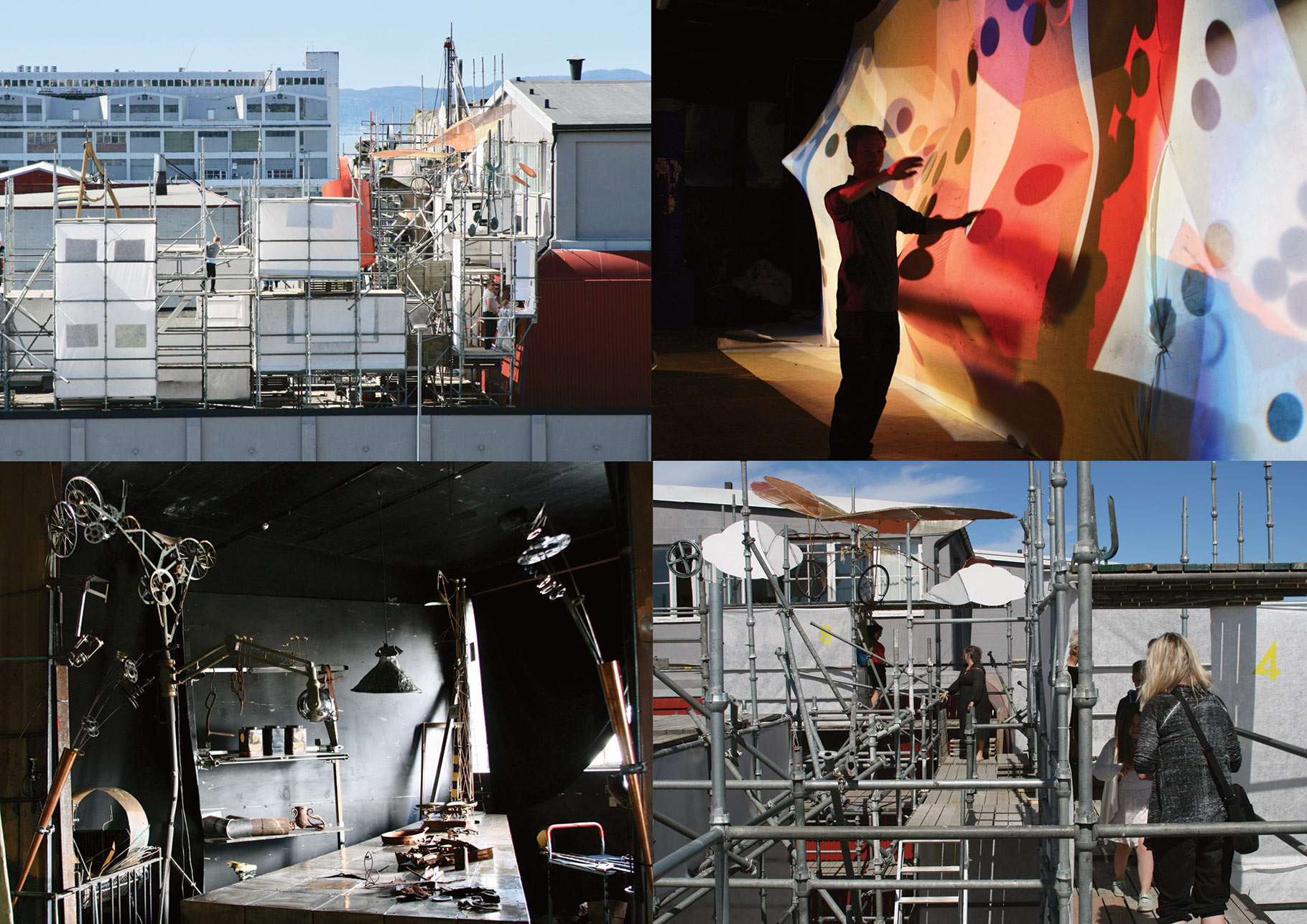
Indoor and outdoor interventions designed and built by the students for the festival. Photo by Johanna Gullberg
The thesis triangulates perspectives on spatiality and learning from architecture, pedagogy and theatre. At its core is an action research case study of the learning processes of fourteen architecture students who followed the Master course Making is Thinking, given at NTNU in Trondheim during the spring semester 2016.[2] During the semester students worked both in the FormLAB, an on-campus learning lab, and in the theatre company Cirka Teater‘s facilities at Nyhavna, a harbour area next to the city centre. The course ended in the first version of the urban festival Hendelser på Nyhavna (Events at Nyhavna), nowadays an established concept that many feel ownership of. The festival was initiated by Cirka Teater and Making is Thinking as a reaction to the political decision on turning Nyhavna into an urban residential area. The refusal to tacitly accept the inevitable force of gentrification led to that cultural producers at Nyhavna opened their doors for a day, thereby letting many experience creative activities that usually remain in the hidden. An effect of “turning Nyhavna inside out” in this festive way, was in fact that arts and culture got recognised as a parameter in the official plans for the area. This parameter has since then been present in architectural competitions, participatory workshops and municipal initiatives regarding the future of Nyhavna.
In the thesis, the notion of transformation is seen through the lense of the educator rather than that of the urban planner – the conversion of Nyhavna forms a background to the study of learning processes in the Making is Thinking milieu. Wherever Making is Thinking educators work, they aim at enabling transformative learning experiences and critical conversations about the professional habits of architects, and their main tactic for doing so is to set up exercises that include hands-on making. In 2016, the exercises were influenced by the site and, more importantly, by the collaboration with the theatre company.[3] For instance, students tested out performative mapping techniques and agreed on being guided by fictive characters as they built the scenography for a festival play. The thesis shows that the exercises brought out embodied, affective and social dimensions of architecture. That these experiential dimensions were unfamiliar to the students, and therefore both potentially transformative and risky or strange, is a major theme in the thesis.
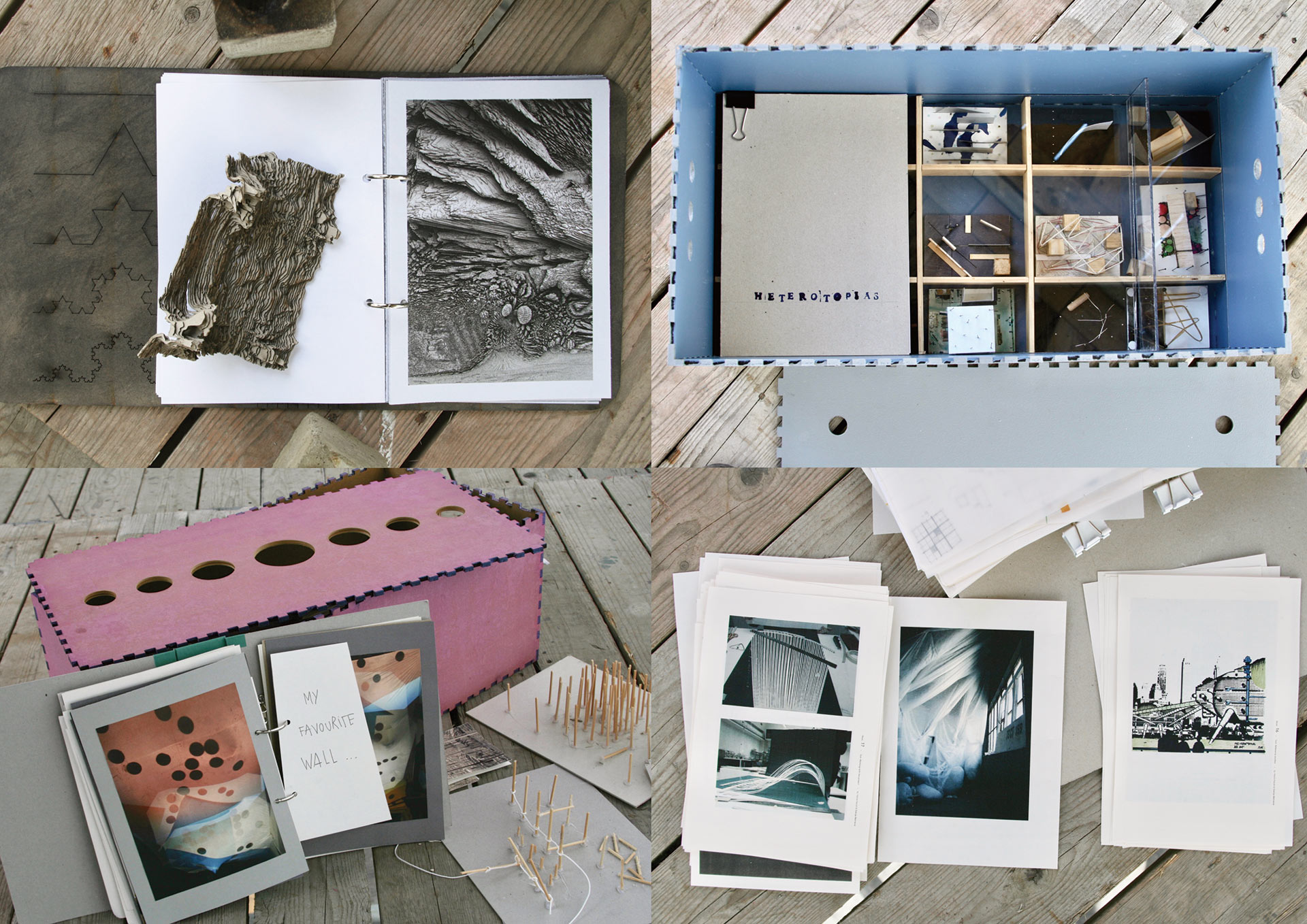
Samples of students’ work boxes and process books, June 2016. Photo by Johanna Gullberg
As they engaged in the course exercises, the students went through two major transformations. First, they started to question and experiment with the divide architects often take for given, namely that between representations of a work and the work itself. While artists often create both the sketch and the final version of a work, architects rarely build the buildings they design in representations such as drawings and models. Experiments with relations between representations to scale and full-scale structures contributed to the students’ awareness of embodied, affective and social dimensions of architecture. Consequently, they were convinced of the value of communicating ideas through built interventions rather than the usual posters with drawings of finished designs. On the festival day at Nyhavna, the students gave guided tours in an exhibition where they used spatial experiences as a tool for encouraging visitors to engage in the future of their city. As one student put it, “it’s one thing to describe something but it’s another thing to experience something.”
Making is Thinking’s hands-on exercises are always combined with forms for reflection, because without reflection there will be no learning. The thesis develops an action research model for cogenerative learning, originally designed by the NTNU sociologist Morten Levin (1946–2023), see Diagram 1.[4] Following Levin’s instructions, a series of four learning arenas – or occasions for dialogue between the students and the researcher – were arranged in relation to the Master course. The aim of the cogenerative model is to support changes of habits and the production of collective knowledge in loops on two levels. It includes one learning loop where the participants’ reflections lead to a local theory, or a shared understanding of the situation, and another loop where the researcher analyses the local situation to establish a more general theory that can be shared in research contexts. Exchanges between the loops are made through conversations in the learning arenas.
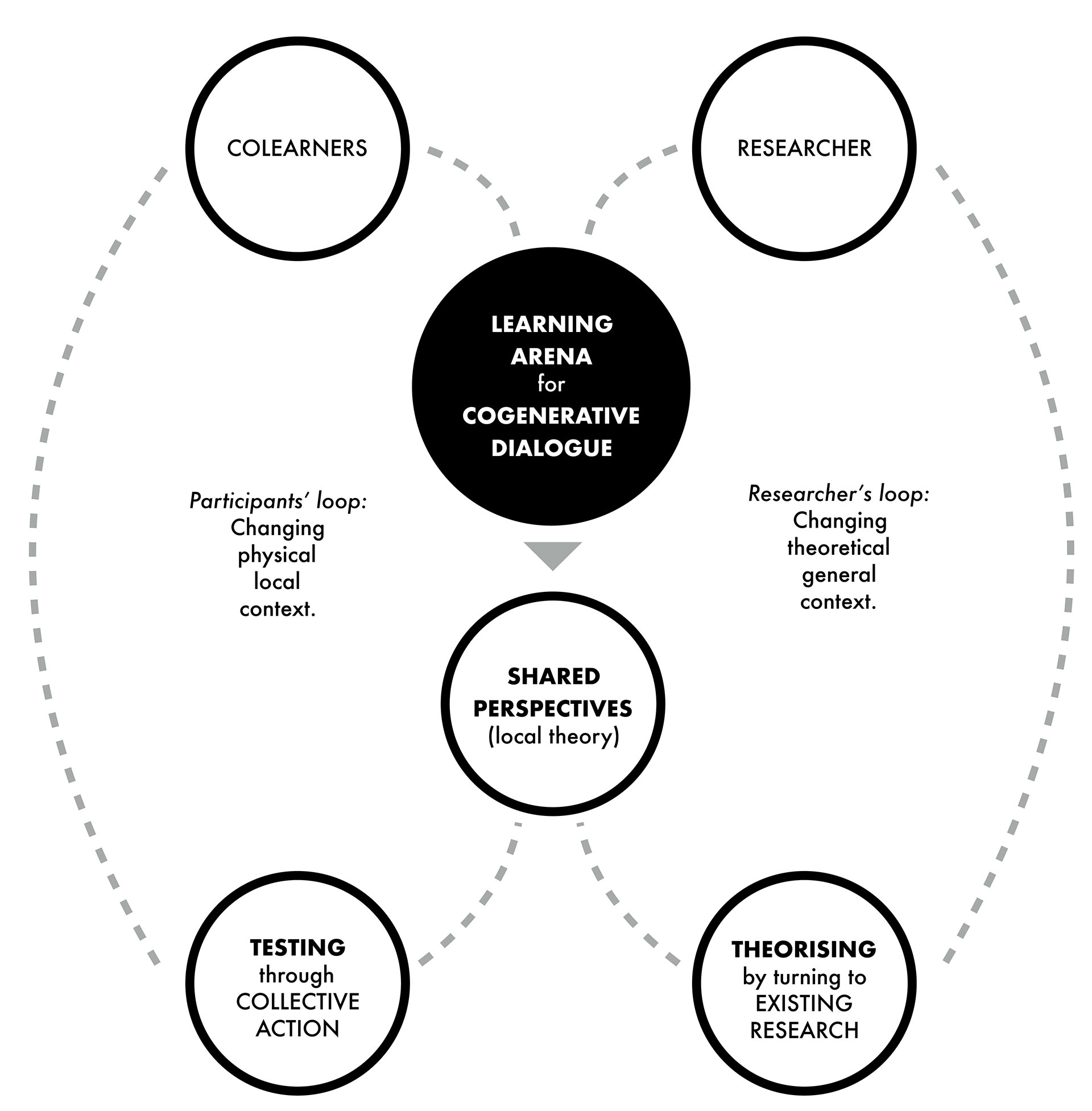
Diagram 1. The cogenerative model as adapted by Gullberg, with loops of physical and theoretical change. The diagram is a combination of Morten Levin’s and Max Elden’s diagram A Model of A Participative Action Research Scandinavia Style: The Cogenerative Way” of from 1991 and Morten Levin’s diagram “The Co-Generative Action Research Model” from 2014. Image by Johanna Gullberg
As mentioned above, embodied, social and affective dimensions of architecture appeared as risky to the colearners in the case studied. To risk something in an educational situation is about doing what one is not trained in, thereby exposing doubts and weaknesses, possibly failing to achieve expected results, but also possibly coming across innovations. A condition for such risk-taking is trust.[5] Yes, a productive tension between risk and trust needs to be in place if renewal is to happen.[6] The thesis shows that to link a structure for reflection such as the cogenerative model to the introduction of unfamiliar forms of learning contributes to the establishment of an atmosphere of trust. The learning arenas enabled the students to articulate their experiences of unfamiliar exercises, and by giving words to the strange they were often convinced of the value in continuing to take risks. This finding is essential, because learners and educators worldwide will need to take risks as they explore new possibilities for architectural education, and the general advise to set up structures for reflection in relation to those explorations should therefore be valuable to many.
Triggered by the cogenerative dialogue in the case studied, where exchanges in the learning arenas were both verbal and material, and by Levin’s idea of the learning arena as a physical yet evolving structure, Cogenerating Spaces of Learning develops the cogenerative model with a focus on material or practice-based dimensions of knowledge. A major motivation for placing emphasis on materiality, is that educators of architecture may be less sceptical to pedagogical models if those models build upon their practice. They may thus, hopefully, embrace their role as dual professionals, and develop their competences both as architects and educators. Moreover, a practice-based cogenerative model is a possibility for enabling more learners to nurture the connection between aesthetic experiences of materiality and verbal articulation. Architects need to practise how to talk about what they do. Yes, existing habits must in fact be articulated if they are to be transformed.
In a more tangible sense, the thesis points to the value of building the new by working with the existing. The bricolage, or the technique to create new art works by using what happens to be available in a given context, is cherished both by Making is Thinking and Cirka Teater. The theatre company has developed a method to build stories by letting found material artefacts and human bodies interact. For architects, the bricolage logic can function as a sustainable counter-position to the habit of first creating a finished design and then go looking for materials. The students in the course learnt to “compose upon the given,” as one of them said, as they produced an abundance of collages, models, drawings and full-scale structures. At first the things through which they communicated were in front of them, in between them on a table, and then those things surrounded them. And from being about sensual experiences, the learning arenas became sensual experiences set up in the FormLAB and on site at Nyhavna. They were not stable platforms where communication happened, but material spaces in the making. These material spaces of learning are possible to frame as evolving aesthetic experiences. They not only allow for communication, transformation and cogeneration, but are also communicative, transformative and cogenerative in themselves and by aesthetic means in the sense that they include materiality and embodied experiences of materiality. In other words, they materialise a mutual dependency between the learner and the context s/he learns in.
To take the idea of the learning space as evolving aesthetic experience further, Cogenerating Spaces of Learning proposes two questions for future research:
1. With the cogenerative model as a point of departure, how can material and transformative spaces of learning be developed within architectural education?
2. Given the importance of the embodied experience in our case, how can performative perspectives on the idea of transformation in and of material space inform the setting up of spaces of learning within architectural education?
The thesis begins to answer the two questions by looking to theories and practices of theatre as well as to research on experiential and performative pedagogies in higher education. The discussion is underlined by an awareness of that while educational milieus may offer possibilites for the individual to transform his or her perspectives, they must be conscious not to push learners to transform in any predefined direction. Historical examples of educational collaborations between theatre and architecture are included in the discussion, and so are also spatial models from performance theory. A selection of such spatial models, from theatre scholars Erika Fischer-Lichte and Arnold Aronson among others, are proposed as vehicles for further developing the cogenerative model and its learning arena as physical yet evolving space.
To apply research to educational practice through the cogenerative model made a difference in the everyday of architecture students and educators. In the learning arenas arranged in relation to the Making is Thinking course, experiences that could otherwise have dispersed because they were unfamiliar and hard to articulate were captured and their importance revealed. In other words, it is important to let architecture students talk about what they do.
This text has been commissioned and written uniquely for Urgent Pedagogies.
1.
Johanna S. Gullberg. Cogenerating Spaces of Learning: The Aesthetic Experience of Materiality and Its Transformative Potential within Architectural Education. Norwegian University of Science and Technology (NTNU), 2021. https://ntnuopen.ntnu.no/ntnu-xmlui/handle/11250/2740718
2.
Making is Thinking is a learning perspective given in various formats both on and off campus, across Bachelor and Master levels, and also in international workshops. For instance, Making is Thinking contributed to the Lisbon architecture triennale in 2016, and has given a number of workshops in the annual International Design Workshop Week at the University of Antwerp.
3.
The exercises were set up by Nina Haarsaker, Nina Eide Holtan, Johanna Gullberg, Gro Rødne, August Schmidt and Sebastian Østlie from Making is Thinking, with contributions from Anne Marit Sæther and Gilles Berger at Cirka Teater.
4.
On the cogenerative model, see Levin, Morten. “Co-Generative Learning.” In The SAGE Encyclopedia of Action Research, edited by David Coghlan and Mary Brydon-Miller, 109–112. London, UK: SAGE Publications Ltd, 2014. See also Elden, Max, and Morten Levin. “Cogenerative Learning: Bringing Participation into Action Research.” In Participatory Action Research, edited by William Foote Whyte, 127–142. Thousand Oaks, CA: SAGE Publications, 1991.
5.
That trust is a condition for risk-taking is supported by contemporary research on education. See for instance Carless, David. “Trust and Its Role in Facilitating Dialogic Feedback.” In Feedback in Higher and Professional Education: Understanding It and Doing It Well, edited by David Boud and Elizabeth Molloy, 90–103. Abingdon, Oxon, UK, and New York, NY: Routledge, 2012.
6.
The idea of a balance between risk and trust has been developed by the author and Gro Rødne, initiator of Making is Thinking, in the paper “Risk, Trust and Big Beautiful Mistakes: Keys to Innovation in Architectural Education,” presented at the annual conference of the European Association for Architectural Education in 2023 and to be published in 2024.
is an architect and educator. She lives in the self-built project Experimental Housing at Svartlamon in Trondheim, Norway (Nøysom arkitekter, 2017). On her desk right now is an illustrated theatre play for architects (dpr-barcelona, in process) and sketches for a story of an architectural expedition. Together with visual artist Line Anda Dalmar, Gullberg is developing a practice on public art at the crossroads of art and architecture. She holds a PhD in architectural theory with a focus in the field of architectural education (NTNU, 2021), and is affiliated with Henning Larsen Architects where she has worked with user involvement processes in large public projects.
Johanna Gullberg’s doctoral thesis Cogenerating Spaces of Learning: The Aesthetic Experience of Materiality and Its Transformative Potential within Architectural Education, defended at NTNU in 2021: https://ntnuopen.ntnu.no/ntnu-xmlui/handle/11250/2740718
